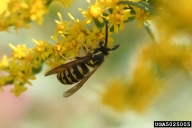… Never. This post was slated to go live the same day Uncle Sam started surcharging tardy tax returns. Then — human error took over.
You don’t have to step back in time, though, for this post to help you — it’s as relevant now as it was on April 15. And it’ll stay relevant year-round. Still, as with so many IPM tactics, the sooner you start the better.
******************** and now for the post:
While Uncle Sam is busy reviewing your 2012 balance sheet, why not take a close look at your IPM 2012 “balance sheet”: your notes or scouting records? Sure, last year’s pest diary can’t predict what will hammer you this year. Still — other than new pests on the prowl, the pool of potential malcontents doesn’t differ much from year to year. You can learn a lot from reviewing which pests harassed you most (or gave you a break).

Especially — if your records say what conditions tended to make problems worse. Did pests blow in on storm fronts from points south; were fields too wet too late; did Jack Frost leave a calling card when you least wanted it?
Conversely, your records could show which growing conditions hammered pests on your behalf.
With all that as your backdrop, what did you do about troubling pests? How well did your tactics work? What did you learn; what could you build on (or do differently) this year? If your records go back several years (a decade would be gravy), you’ve got lots of good material to draw on for evidence-based, least-toxic decisions about what to do when nature throws you a wild card.

Whether you’re a farmer, landscaper, groundskeeper, or gardener, we’re right there to suggest what cards to play. Tune into our timely pest forecasts, trap networks, and field reports to get a heads-up on what’s headed your way. And tweak the cultural and scouting practices that — for instance — favor healthy plants that shrug off disease or let you know that a pest’s natural enemies are about to take command.
IPM helps you make those evidence-based decisions — decisions that emphasize, for instance, resistant plant varieties, sanitation, the right nutrients at the right time, or pheromone traps that act like “come-hither” baits for pests otherwise intent on eating your crops. Prevention, in a word.
And while you’re at it — why not review our research reports to see what we’re learning? Example: maybe your records show you spent $60± per acre on preventive fungicides for field corn — fungicides that, according to belief, also promote higher yields. Or do they? We did the work and the math on a real-world farm and we’re thinking — not so fast. Because in this case, the farmer would take a hit of about $40 per acre on sprays that didn’t really improve yields all that much.
Your records are just as valuable for both pests, inside or out, at the schools,

warehouses, concession stands, or rental properties you care for. Maybe last fall you saw way too many yellowjackets at the dumpster — but you can take steps early to prevent more of the same. Similarly, you’ll want to scout early whether it’s ants, stink bugs, cockroaches or mice knocking at your door.
The operative word: early. Which is why this review matters so much. Because late may as well be never.